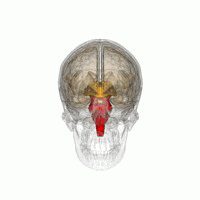Locked-in Syndrome
(Redirected from Locked-in syndrome)
Locked-in syndrome is a type of brain damage, for which is typical a destruction of brainstem and preserved brain cortex. The symptoms are derived from a function of these parts of the brain, so people are conscious, can perceive the environment and think, but they are not able to do any voluntary movement at all (complete paralysis). The only possible movement is the movement of the eyes. Also the autonomic functions (respiration, swallowing, salivation, heart rate,...) are not retained, so the patients need supportive therapy (e.g.: artificial ventilation, nutrition).
Etiology[edit | edit source]
The most common reason of lock-in syndrome is some brain trauma or hypoxia, which is usually connected with a pontine infarction. The next option are diseases, which affect myelin sheath or medication overdose.
Symptoms[edit | edit source]
- complete paralysis – impossible to voluntary movement
- eye movement is possible – patients can communicate by eye blinking
- it´s impossible to speak
- consciousness is preserved (pseudocoma) – the patients perceive the environment
- the patients need a support of autonomic functions – arteficial respiration, nutrition, ...
- lower cranial nerve palsy
Therapy and Prognosis[edit | edit source]
There is no specific therapy of locked-in syndrome. The only treatment is a supportive therapy. In some cases is also used neuromuscular stimulation of affected muscles, but a result is not very good. The prognosis of this disease is very bad and it usually leads to the death within few months or years. People usually die because of some breath insuficience or pneumonia.


